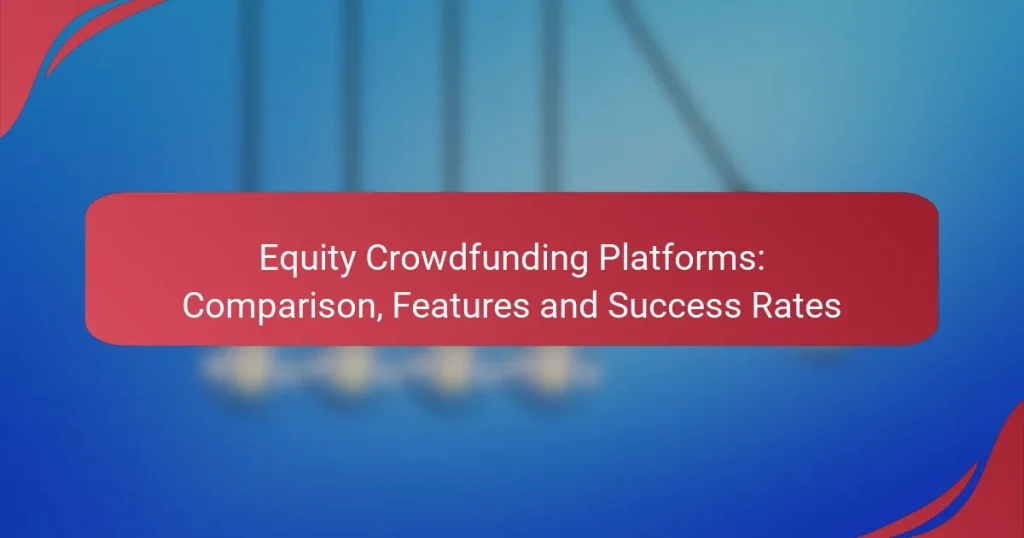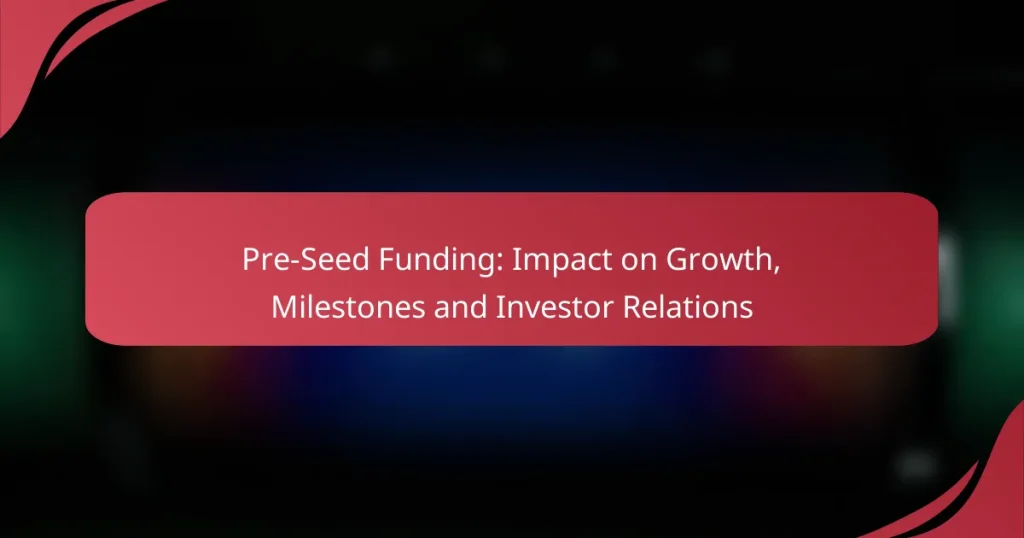Understanding the various funding rounds is essential for tech startups seeking to navigate their growth journey effectively. From Seed funding to Series C and Pre-IPO stages, each round plays a crucial role in providing the necessary capital for development and expansion. By grasping the significance of these funding phases, startups can better position themselves to attract investors and achieve their business goals.
Due Diligence: Importance, Process and Key Considerations
Convertible Notes: Structure, Benefits and Risks
Seed Funding vs. Series A: Which Is Better and When to Use
Equity Crowdfunding Platforms: Comparison, Features and Success Rates
Pre-Seed Funding: Impact on Growth, Milestones and Investor Relations
Series B Funding Round: Preparation Steps, Key Metrics and Investor Insights
What are the key funding rounds for tech startups?
The key funding rounds for tech startups include Seed, Series A, Series B, Series C, and Pre-IPO funding. Each round serves a distinct purpose in a startup’s growth journey, providing necessary capital at various stages of development.
Seed funding
Seed funding is the initial capital raised to support a startup’s early development. This round typically involves smaller amounts, often ranging from a few thousand to a few million dollars, and is usually sourced from angel investors, friends, or family.
Startups use seed funding to validate their business idea, develop a prototype, or conduct market research. It’s crucial to clearly articulate your vision and potential to attract early investors.
Series A funding
Series A funding follows seed funding and focuses on scaling the business model. This round generally raises between $2 million and $15 million, often from venture capital firms.
During this phase, startups should demonstrate a solid user base and a clear path to profitability. Investors look for strong metrics and a well-defined business strategy to ensure their investment will yield returns.
Series B funding
Series B funding aims to expand a company’s market reach and scale operations. This round typically involves larger investments, ranging from $10 million to $30 million, and attracts more institutional investors.
Startups in this stage should focus on refining their product and increasing their market share. It’s important to have a proven track record of growth and a strategic plan for future expansion to secure this funding.
Series C funding
Series C funding is intended for scaling the business further, often to prepare for an IPO or acquisition. This round can raise substantial amounts, often exceeding $30 million, and involves venture capitalists, private equity firms, and hedge funds.
At this stage, companies should have a solid market presence and a clear competitive advantage. Investors expect detailed financial projections and plans for growth to justify their investment.
Pre-IPO funding
Pre-IPO funding occurs just before a company goes public, providing the last round of capital to strengthen its balance sheet. This funding can vary widely, often reaching hundreds of millions of dollars.
Startups should focus on solidifying their market position and demonstrating financial stability to attract investors. This round is critical for ensuring a successful public offering and should be approached with a comprehensive strategy for investor relations and market readiness.
How do tech startups secure seed funding?
Tech startups secure seed funding through various methods, primarily by attracting early-stage investors who believe in their vision. This initial capital is crucial for product development, market research, and operational costs.
Angel investors
Angel investors are affluent individuals who provide capital for startups, often in exchange for convertible debt or ownership equity. They typically invest during the seed stage, offering not just funds but also mentorship and industry connections.
When seeking angel investment, startups should prepare a compelling pitch that outlines their business model, market potential, and financial projections. It’s common for angel investments to range from tens of thousands to a few million dollars, depending on the investor’s confidence in the startup’s potential.
Crowdfunding platforms
Crowdfunding platforms allow startups to raise small amounts of money from a large number of people, usually via online platforms. This method democratizes funding and can validate a business idea through public interest.
Successful crowdfunding campaigns often require a well-crafted marketing strategy and an engaging presentation of the product or service. Platforms like Kickstarter and Indiegogo enable startups to set funding goals, and it’s common for campaigns to raise anywhere from a few thousand to several hundred thousand dollars, depending on the project’s appeal.
Accelerators and incubators
Accelerators and incubators provide startups with funding, mentorship, and resources in exchange for equity. These programs typically last a few months and culminate in a demo day where startups pitch to potential investors.
Joining an accelerator can significantly boost a startup’s visibility and credibility, often leading to follow-on funding. While accelerators may offer seed funding in the range of $20,000 to $150,000, the real value lies in the network and support they provide, which can be pivotal for early-stage companies.
What factors influence Series A funding success?
Series A funding success is influenced by several key factors, including market traction, team experience, and business model viability. Understanding these elements can significantly enhance a startup’s chances of securing investment.
Market traction
Market traction refers to the evidence that a startup’s product or service is gaining acceptance in the market. This can be demonstrated through metrics such as user growth, revenue generation, or partnerships. Investors typically look for startups that show a clear upward trend in these areas, indicating a strong demand for their offering.
Startups should aim to achieve measurable milestones, such as acquiring a specific number of active users or generating a certain level of monthly recurring revenue. For example, demonstrating a 20-30% month-over-month growth in users can be compelling evidence of traction.
Team experience
The experience and expertise of a startup’s founding team play a crucial role in attracting Series A funding. Investors often favor teams with a proven track record in relevant industries or successful previous ventures. A strong team can instill confidence in investors regarding the startup’s ability to execute its business plan.
Startups should highlight the backgrounds of their key team members, emphasizing any relevant achievements or skills. For instance, a founder with prior experience in scaling a tech company can significantly enhance the startup’s credibility.
Business model viability
A viable business model is essential for securing Series A funding. Investors want to see a clear path to profitability and a sustainable revenue generation strategy. This includes understanding customer acquisition costs, pricing strategies, and potential profit margins.
Startups should clearly articulate how their business model works and provide projections for future growth. For example, a subscription-based model with low churn rates can be appealing, as it indicates predictable revenue streams. It’s important to avoid overly complex models that may confuse potential investors.
What are the typical terms in Series B funding?
Series B funding typically involves terms that focus on scaling the business, with an emphasis on valuation, equity dilution, and investor rights. These terms are crucial for both the startup and the investors, as they define the financial and operational landscape for the next growth phase.
Valuation cap
The valuation cap in Series B funding sets a maximum company valuation at which investors can convert their investment into equity. This cap protects early investors by ensuring they receive a favorable conversion rate if the company’s valuation increases significantly in subsequent rounds. Commonly, valuation caps can range from tens of millions to over a hundred million USD, depending on the startup’s growth trajectory.
Equity dilution
Equity dilution occurs when new shares are issued during Series B funding, reducing the ownership percentage of existing shareholders. Founders and early investors should be aware that dilution can be significant, often ranging from 15% to 30% in this round. It’s essential to balance the need for capital with the potential impact on ownership and control.
Investor rights
Investor rights in Series B funding often include preferences such as liquidation preferences, anti-dilution provisions, and board representation. These rights protect investors’ interests and can influence decision-making within the company. Startups should negotiate these rights carefully to ensure they maintain operational flexibility while providing necessary assurances to investors.
How do tech startups approach venture capitalists in Series C funding?
Tech startups typically approach venture capitalists in Series C funding by demonstrating significant growth and a clear path to profitability. At this stage, they often seek larger investments to scale operations, expand market reach, or develop new products.
Pitch deck preparation
Preparing a compelling pitch deck is crucial for attracting venture capitalists during Series C funding. The deck should clearly outline the startup’s business model, market opportunity, financial performance, and future growth strategy. A well-structured presentation can significantly enhance the chances of securing funding.
Key elements to include in the pitch deck are a strong executive summary, detailed financial projections, and a clear explanation of how the funds will be utilized. Startups should aim for a concise yet informative format, typically around 10-15 slides, to maintain investor interest.
Common pitfalls include overloading the deck with information or failing to address potential risks. Startups should focus on clarity and impact, ensuring that each slide communicates essential information effectively. Practice delivering the pitch to refine the message and anticipate questions from potential investors.






